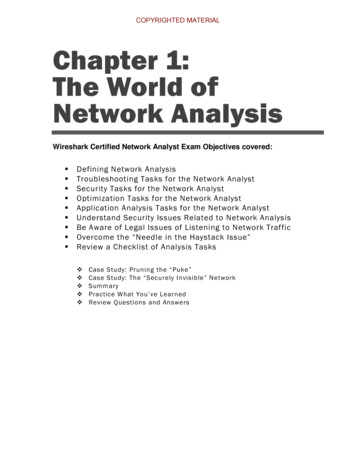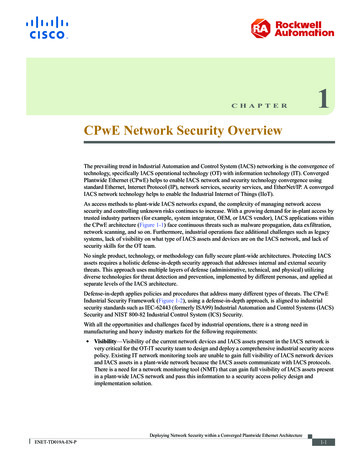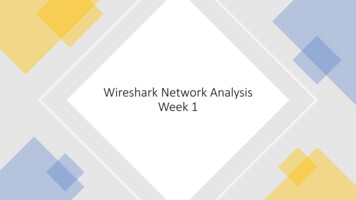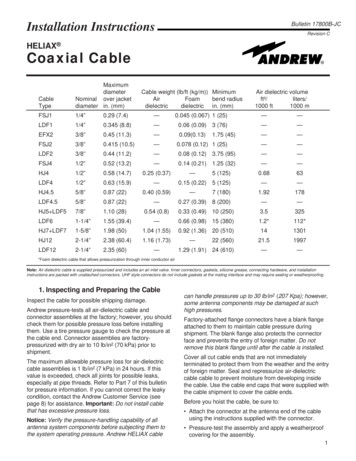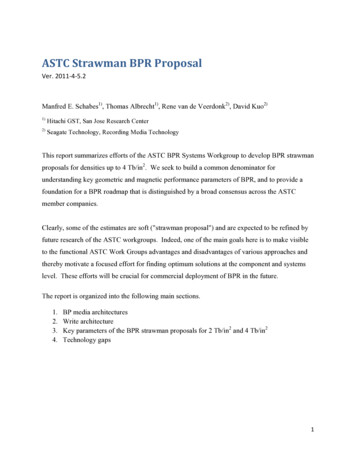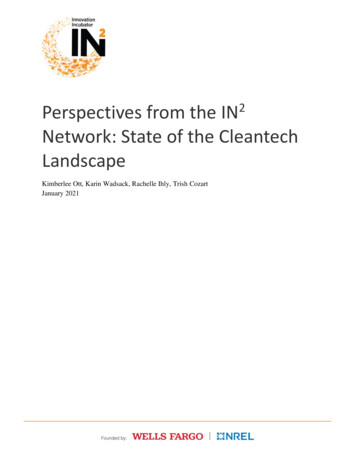
Transcription
Perspectives from the IN2Network: State of the CleantechLandscapeKimberlee Ott, Karin Wadsack, Rachelle Ihly, Trish CozartJanuary 2021
AcknowledgementsWe would like to thank all the Channel Partners who contributed their valuable time to provide data,participate in phone interviews, and reach out to their portfolio companies for data. Without you, thispaper would have not been possible. We also want to extend a special thank you to the eight leads thatcollected data and interviews with partners in their regions: Cleantech Open, Innosphere, Larta Institute,Launch Alaska, New Energy Nexus, Northeast Clean Energy Council (NECEC), Wilton E. Scott Institute forEnergy Innovation at Carnegie Mellon University, and Jon Brumley Texas Ventures Lab at the Universityof Texas Austin. In addition, we want to thank the partners who participated in in-depth interviews: WiltonE. Scott Institute for Energy Innovation at Carnegie Mellon University, Caltech Rocketfund, ElementalExcelerator, The Yield Lab, AeroShield, CoverCress, UbiQD, and Yotta Energy. Lastly, we’d like to thankCleantech Group for their efforts in creating and distributing a diversity survey to the network. Theseefforts will enable a benchmark against which this network will measure future success.Partners:ii
ACRE New York, NYAgLaunch Memphis, TNAgSprint Las Cruces, NMAgStart Woodland, CAAnn Arbor SPARK Ann Arbor, MIBioGenerator St. Louis, MOBRITE Energy Innovators Warren, OHCaltech, FLOW Program Pasadena, CACarnegie Mellon University Pittsburgh, PACentrepolis Accelerator Southfield, MIClean Energy Trust (CET) Chicago, ILCleantech Group San Francisco, CACleantech Open Los Angeles, CACoachella Valley Economic Partnership Palm Springs, CAColorado Cleantech Industries Association(CCIA) Golden, COColorado State University Energy Institute,Powerhouse Fort Collins, COCyclotron Road Berkeley, CA Daugherty Water for Food GlobalInstitute at the University of Nebraska Lincoln, NE Dominion Energy Innovation Center Ashland, VAElemental Excelerator Honolulu, HIF3 Tech Accelerator Easton, MDFORGE Somerville, MAGreentown Labs Sommerville, MAHelix Center St. Louis, MOImagine H2O, Inc. San Francisco, CAInnosphere Fort Collins, CO Innovation Corridor Foundation Denver,COInnovation Crossroads Oak Ridge, TNLarta Institute Los Angeles, CALaunch Alaska Anchorage, AKLos Angeles Cleantech Incubator LosAngeles, CAMaRS Discovery District Toronto, CAMass Challenge Boston, MAMIT Energy Club Boston, MANew Energy Nexus San Francisco, CA NextEnergy Center Detroit, MINorth Carolina Biotechnology Center(NCBiotech) RTP, NCNortheast Clean Energy Council (NECEC)Institute Boston, MANorthwestern University Evanston, ILPortland State University BusinessAccelerator Portland, ORPowerhouse Oakland, CAProspect SV San Jose, CARice University Houston, TXStanford, TomKat Center for SustainableEnergy Stanford, CASustainable Startups Salt Lake City, UTTechAccel St. Louis, MOTHRIVE Los Gatos, CATexas A&M Engineering Experiment StationClean Energy Incubator (TAMCEI) CollegeStation, TXTexas State University San Marcos, TXThe Water Council Milwaukee, WIThe Yield Lab St. Louis, MOUniversity of California, Berkeley Berkeley,CAUniversity of California, Davis Energy andEfficiency Institute (EEI) Davis, CAUniversity of California, San Diego SanDiego, CAUniversity of Colorado Boulder Boulder, COUniversity of Denver Denver, COUniversity of Georgia, Innovation Gateway Athens, GAUniversity of North Carolina, Institute for theEnvironment Chapel Hill, NCUniversity of Texas at Austin, AustinTechnology Incubator (ATI) Austin, TXUniversity of Texas at Austin, Texas VentureLabs Austin, TXUniversity of Washington Seattle, WAUniversity of Wisconsin-Madison, WisconsinEnergy Institute Madison, WIVertueLab Portland, ORYale Center for Business and theEnvironment New Haven, CT
Table of ContentsRESEARCH MOTIVATION . 1BACKGROUND & METHODS . 1EXISTING RESEARCH ON THE CLEANTECH ECOSYSTEM . 3LANDSCAPE ANALYSIS: PARTNERS AND THE COMPANIES THEY SERVE. 5IN2 NETWORK PARTNERS: A RANGE OF SERVICES PROVIDED. 5THE STARTUP COMPANIES: LOCAL HUBS, BUT MANY CROSS-COUNTRY CONNECTIONS . 6STARTUPS UTILIZING MORE OF THE NETWORK. 6THE STARTUP LANDSCAPE: LOCATION, STAGE, & TECHNOLOGY . 7Location May Not Matter Anymore . 7The Pipeline is Not Drying Up . 7Twenty Years of Innovation . 8Tech Focus and Stage Around the Country. 9Demographics . 10DIFFERENT ROLES FOR UNIVERSITIES AND NATIONAL LABORATORIES . 11The Role of Universities: Origination and IP . 11The Role of National Labs: Partnership to Advance Innovations . 12The Importance of Reputational Vetting . 12GAPS ANALYSIS . 13FACTORS DRIVING SUCCESS. 16KEY FINDINGS & RECOMMENDATIONS . 17REFERENCES . 19APPENDIX: SUPPLEMENTARY INFORMATION . A1iv
Research MotivationThe need for high impact cleantech innovations is more pressing than ever. In order to support thetransition to a low-carbon economy, the cleantech ecosystem needs to accelerate and de-risk newtechnologies. Where are the companies 1 launching these new technologies located, what resources areavailable to enable this transition, and who will fund them?The Wells Fargo Innovation Incubator (IN2) is a technology incubatorfunded by the Wells Fargo Foundation and administered by theNational Renewable Energy Laboratory (NREL). IN2 involves andfosters a network of more than 60 cleantech accelerators, incubators,funds, and university programs across the United States, referred toas channel partners in the program.2 These partners provide supportto more than 6,000 cleantech startups ranging in stage from benchscale to commercially ready (descriptions of these terms are in theAppendix, Table 1).The NREL and Wells FargoInnovation Incubator (IN2)partners provide a range ofsupport services to more than6,000 cleantech companiesacross the United States.The term ‘cleantech’ is used here as an umbrella concept that includes any company or organizationadvancing the clean energy economy by aiding the transition to a low-carbon future. NREL’s cleantechnetwork includes companies ranging from solar power to agricultural solutions (a full list of technologyfocus areas can be found in the Appendix, Table 2). Startups require various types of services and supportto enable their transitions to profitable and sustainable companies, and as such, partners offer servicesincluding, but not limited to, business and/or technology incubation, funding (dilutive and non-dilutive),and exposure through mechanisms like pitch competitions.The goal of this white paper is to establish an understanding of the current cleantech landscape throughthe lens of this network by assessing who the network is supporting, geographic trends across the UnitedStates within cleantech, and the influence of universities and national labs on entrepreneurship. A gapanalysis follows, which highlights needs in the ecosystem. Key findings and recommendations related toecosystem function are also presented based on robust data analysis and in-depth interviews.Background & MethodsIn 2019, IN2 convened its network partners to share knowledge and best practices. During a breakoutsession focused on the pipeline of cleantech innovation, two major themes emerged: 1There is a perceived focus on startup maturations and scaling. Some network partnersreported not seeing many early-stage startups.Because of this perceived focus on maturation, there was a concern that there might not bea healthy pipeline of companies accessing incubator or accelerator programs, depending onlocation.Company and startup are used interchangeably throughout this paper. Startup is defined as “a temporaryorganization designed to look for a business model that is repeatable and scalable.” (Areito 2018)2 One Channel Partner, MaRS Discovery District, is located in Toronto, Ontario, in Canada.
To further explore these ideas, IN2 appointed eight leads from within the network: Cleantech Open,Innosphere, Larta Institute, Launch Alaska, New Energy Nexus, Northeast Clean Energy Council (NECEC),Wilton E. Scott Institute for Energy Innovation at Carnegie Mellon University, and Jon Brumley TexasVentures Lab at the University of Texas Austin, to interview the other partners in their regions and collectdata on their portfolio companies. Each partner was asked to provide the information shown in Table 1about their cleantech portfolio companies. (Only data for U.S.-based companies prior to January 1, 2020were requested.) Partners were asked to report up to 100 companies or two years of participant companydata – whichever came first. Forty-nine partners provided data for this paper, resulting in data about 1,363unique cleantech companies spanning 45 states. 3Table 1: Cleantech portfolio company data requested of network partners.Data Collected on Each CompanyOptional Data ReportedAdditional Data Sourcedfrom PitchbookCompany nameWebsiteTechnology focus area*Amount and type(s) of fundingraisedRevenueStage of technology*RevenueNumber of employeesYear entered and exited programNumber of employeesYear foundedCompany name (if changed)Customer(s) (name or type)Amount and type(s) offunding raisedLocation while in program and currentlocationCompany origination(university, national lab, independentlygenerated, or other)Licensed IPCompany status(active, closed, unknown)Company exit*Definitions of stages and technology focus are located in the Appendix.3Data provided by partners do not represent the entirety of the companies they support. Partners support notonly cleantech companies, but also other verticals within the U.S. and across the globe, totaling more than 6,000companies.2
In addition to providing data about their cohorts of companies, participating partners were interviewedby leads via phone or email to determine their organizational type, technology area of focus and whetherthose area(s) have changed, services offered and whether those service(s) have changed, number ofcompanies supported, and number and types of opportunities provided to portfolio companies.Once interviews and data were collected from each partner, leads provided the data to IN2. The data wasreviewed for consistency and completeness, then aggregated. Company names and locations were thenused to pull additional data from Pitchbook, which was combined with the master data spreadsheet for acomprehensive analysis. While not all cleantech programs nor startups are represented with these data,these data provide a fairly recent snapshot 4 into the cleantech ecosystem.Data analysis was conducted in the following four main areas: Landscape of the network (size, stage, technology focus, etc.)Geographic trendsInfluence of universities and national labsDemographics and diversity.In addition to these data collected, IN2 conducted in-depth interviews with network partners and startups.These interviews served to augment the data and help inform a more robust understanding of thecleantech landscape. To form a baseline of understanding on diversity and inclusion in cleantech, IN2partnered with the Cleantech Group to conduct interviews and a survey. Surveys were sent to cleantechstartups and network partners.Existing Research on the Cleantech EcosystemMany reports have analyzed the cleantech ecosystem, focusing on the amount of public and privatecapital found in the sector over time, and how cleantech companies perform in comparison to otherstartup types such as biotech and software. Reports focusing
(CCIA) Golden, CO . used to pull additional data from Pitchbook, which was combined with the master data spreadsheet for a comprehensive analysis. While not all cleantech programs nor startups are represented with these data, these data provide a fairly recent snapshot4 into the cleantech ecosystem. Data analysis was conducted in the following four main areas: Landscape of the network .

